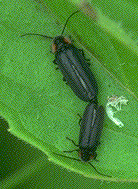
University of Kentucky Department of Entomology







Entfact 807
By Lana Unger,
|
 Corel PhotoCD | The most common light-producing insect is the firefly. Firefly adults glow or flash their light while flying around at night. Firefly larvae, often called glowworms, flash their light on the ground. |
Fireflies have light-producing chemicals in special organs inside their abdomens. The light produced by fireflies has been called perfect light. This is because in the production of light, no energy is wasted as heat. A light bulb does not produce perfect light like fireflies. If you have ever touched a light bulb after it has been on for a while, you know that the light bulb gets very hot and you have to be careful not to burn yourself.
Fireflies use their light to attract mates. Males fly around flashing their light off and on trying to attract a female. The females sit on the ground and flash responses to the males. Different species of fireflies use different flash patterns and rhythms. Some species may only flash at a particular time of the evening.
ACTIVITY
Firefly game
Things you will need:
- several flashlights
- paper
- pen or pencil
This is a role-playing group activity. The object of the activity is for the female fireflies to choose a "mate" of the same species by choosing the mate with the correct flash pattern. Divide the group in half. One group will be male fireflies and the other group will be female fireflies. Separate the participants into two "species" groups, "species A" and "species B". Do this by writing "A" or "B" on small pieces of paper. Assign each species group a specific flash pattern and write it on the piece of paper with the species letter. For example, species "A" could have a flash pattern of three short flashes and species "B" could have a different flash pattern of one short flash followed by two long flashes. Let the participants chose a species out of a container with all the pieces of paper in it. The participants should keep their species identification and their flash pattern secret. Give all of the males fireflies a flashlight and have all the female fireflies sit on the ground in a circle. The males will walk around the middle of the circle flashing their specific pattern. When a female recognizes her species flash pattern, she will ask the male to leave the circle. When all fireflies are paired, everyone should reveal their species to see if they were able to attract the proper species of mate.
DEMONSTRATION
Use a light stick, often found in sporting good shops, to demonstrate how chemicals can mix together to create light without putting off any heat. These light sticks are often used by campers and hikers as a ready source of light.
Insects All Year and Firefly cartoons courtesy of C. Ware, copyright 1998
Fireflies image, Corel PhotoCD, copyright 1996
Last updated: 22 January 1999

 Return to UK Department of Entomology Katerpillars page
Return to UK Department of Entomology Katerpillars page Return to UK Department of Entomology homepage
Return to UK Department of Entomology homepage Return to University of Kentucky homepage
Return to University of Kentucky homepage